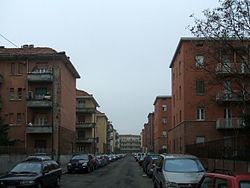Time zone CET (UTC+1) | Zone 6 | |
 | ||
Restaurants Different Burger, Trap of Taste Restaurant, wakousu, Asaka, Il Trespolo | ||
Giambellino and Lorenteggio are two historical and populous residential blocks of Milan, Italy. Together, they form a district ("quartiere") which is variously called "Giambellino", "Lorenteggio", Giambellino-Lorenteggio or Lorenteggio-Giambellino; the district is part of the Zone 6 administrative division of Milan.
Contents
Map of Giambellino, Milan, Italy
The district is centered along two parallel streets (more than 2 km long), Via Giambellino and Via Lorenteggio, that extend from the south-west of Milan outwards to the border of the comune of Corsico. These two main streets house a number of shops and stores, and together form a peripheral shopping district. The area is nevertheless mainly residential, with both high-income housing (especially in the area of Via Soderini, Via Arzaga, Via San Gimignano, and the innermost part of Via Lorenteggio) and low-income housing (especially in Via Giambellino and the peripheral part of the district).
History
The original, rural settlement from which the district evolved was a rural comune named "Lorenteggio e Uniti". The toponymy "Lorenteggio", in turn, comes from the diminutive "Laurentiglio" of proper noun "Laurente". In 1800, Lorenteggio had 143 inhabitants. In 1841, part of Lorenteggio was annexed to Corsico, while the rest became part of the Corpi Santi comune. The boundary between these two parts was a toll-gate. The toll-gate building has been completely renewed, but it still marks the boundary between Milan and Corsico and it is still referred to as "Il Dazio" ("the Toll-gate"); nowadays, it has been adapted as a restaurant (it was a McDonald's restaurant for several years).
Lorenteggio kept its rural character until the late 19th century, its territory being partitioned into several cascine (farmhouses), some of which existed well into the 20th century. In the 20th century, Lorenteggio was annexed to Milan, and a quick urbanization and industrialization process started. The industrial development of the area was boosted by the construction of the railway connecting Milan to the south-west of Lombardy, in the early 1900s; the San Cristoforo railway station, completed in 1909, is still in operation. One of the most famous factories that were established in Lorenteggio is that of the Osram lighting manufacturer.
Massive construction of apartment blocks in Lorenteggio began in the mid 20th century. The district today is completely urban, with the last remainders of the rural landscape being only found past the boundary of Corsico.
Transportation
The Giambellino-Lorenteggio district is well-connected to the centre of Milan, with several Milan Metro stops within its area, as well as a number of tramways (on Via Giambellino) and bus lines. In fact, Via Lorenteggio is the main thoroughfare connecting the Milanese south-west to the centre; it is the continuation of the Strada Vigevanese, a prominent Lombard road that connects Milan to Vigevano. The district also includes part of the Circonvallazione ring road, which is served by two trolleybus lines, respectively going clockwise and counterclockwise. The outermost part of the district houses several capilinea of interurban buses going to nearby comuni such as Assago, Trezzano sul Naviglio, Corsico, and Buccinasco. Next to the border to Corsico is also the San Cristoforo railway station, which connects the district inwards to Porta Genova in Milan and outwards to Abbiategrasso and Mortara in Lomellina. There is a plan for a new Milan Metro station to be realized at San Cristoforo station; this will also provide a direct connection from the district to the Linate Airport.
Church of Saint Protasius
Via Lorenteggio and Via Giambellino have very few historical buildings, as most buildings were realized in the 1960s or later; yet, the district has a very unusual landmark in the medieval church of Saint Protasius. This is a very small and simple church, which was scheduled for demolition when the modern street of Via Lorenteggio was built. The local population strongly opposed this decision; in fact, as the church is so small, it could be preserved by enclosing it in the traffic island separating the two lanes of Lorenteggio. Although of little architectonic value, the church is very ancient (dating back at least to the 11th century), has some interesting (although badly preserved) frescos, and is strongly connected to the Milanese tradition. According to a well known legend, for example, Frederick I Barbarossa prayed in this church before the siege of Milan.
